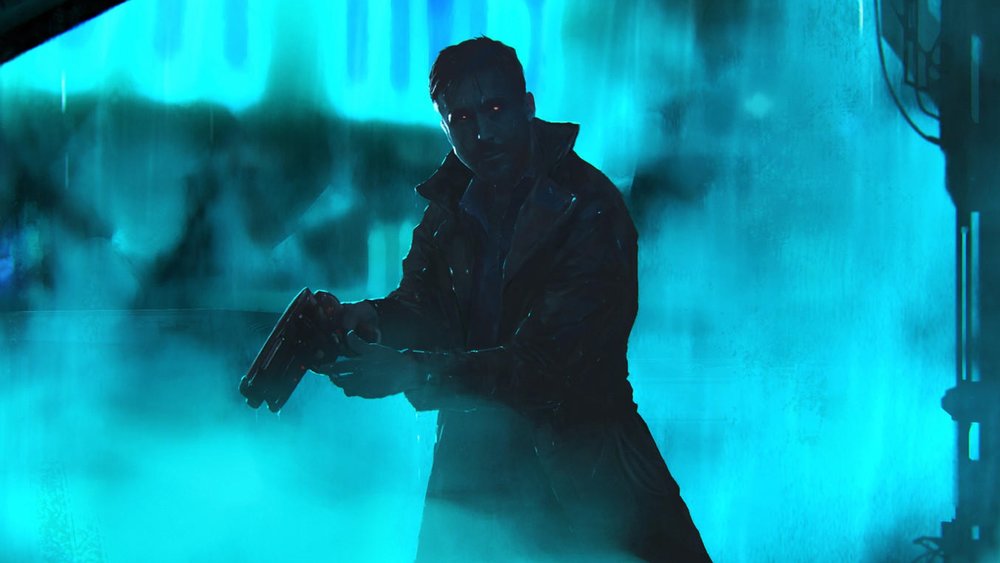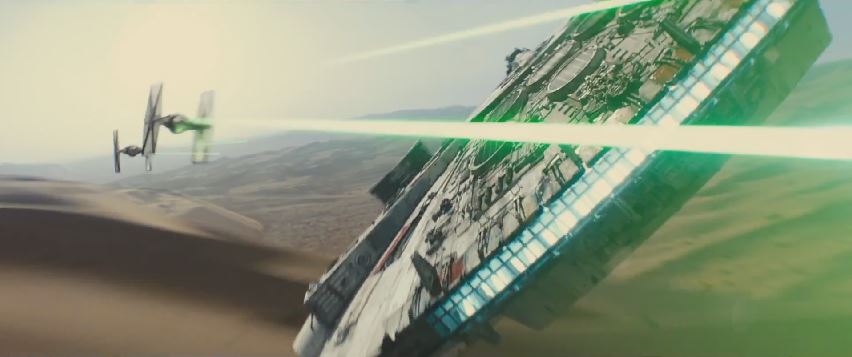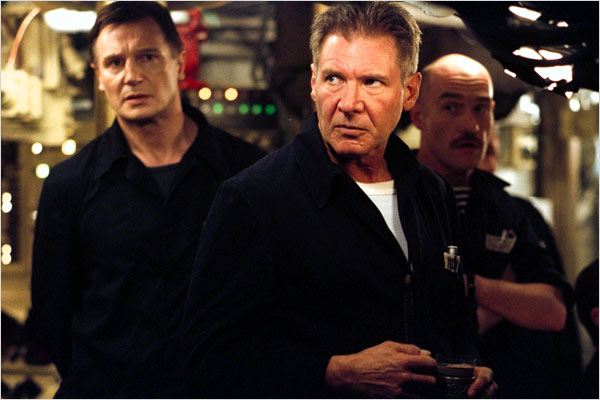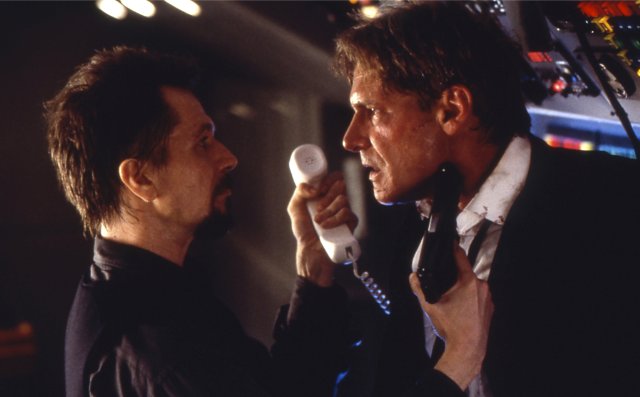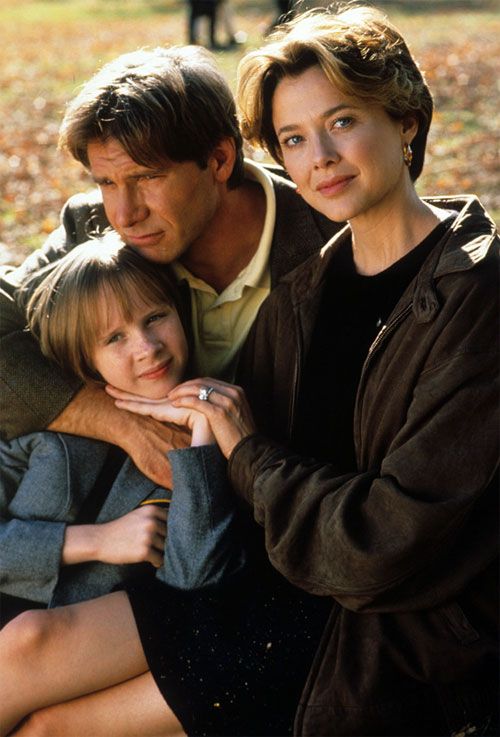Blade Runner 2049 (2017)
CAST: Ryan Gosling, Harrison Ford, Robin Wright, Ana de Armas, Sylvia Hoeks, Jared Leto, Dave Bautista
REVIEW:
WARNING: WHILE THIS REVIEW ATTEMPTS TO AVOID MAJOR “SPOILERS”, IT WILL REVEAL ASPECTS OF THE FILM’S PLOT
Thirty-five years ago, Ridley Scott directed Blade Runner, which while receiving mostly negative critical reviews and failing to make back its budget at the box office (Harrison Ford fans likely expected something more action-oriented than what was on display), gained a cult following and is held up today as a visionary sci-fi classic. In the intervening decades, Scott has occasionally returned to the Blade Runner universe with a 1992 director’s cut and a 2007 “final cut”, while speculation about a follow-up percolated, which has finally been brought to the screen by Denis Villeneuve (Sicario, Prisoners, Arrival), who took over directorial duties when Scott stepped down due to scheduling conflicts with Alien: Covenant (although he remains credited as producer). While perhaps slightly less obtuse, Blade Runner 2049 maintains the tone and pacing of its forefather (which, depending on who you ask, might be a good or bad thing) and is a close cousin. To those for whom the original Blade Runner is not their cup of tea, 2049 seems unlikely to convert them, but those with high regard for Scott’s 1982 film may find much to appreciate about this long-awaited return to its dark world. Continue reading
Star Wars Episode VII: The Force Awakens (2015)
CAST: Daisy Ridley, John Boyega, Oscar Isaac, Adam Driver, Harrison Ford, Carrie Fisher, Mark Hamill, Domhnall Gleeson, Lupita Nyong’o, Max von Sydow, Gwendoline Christie, Andy Serkis, Peter Mayhew, Anthony Daniels, Kenny Baker
REVIEW:
With 1977’s Star Wars (at the time simply titled “Star Wars”, later as Star Wars Episode IV: A New Hope), writer-director George Lucas launched a pop culture phenomenon that has arguably never seen its equal (Harry Potter mania might be the closest runner-up), and 1980’s The Empire Strikes Back and 1983’s The Return of the Jedi only solidified its status. It’s hard to overestimate Star Wars‘ influence on the filmmaking industry, whether bringing sci-fi into the mainstream, hearkening back to the old-fashioned adventures of Flash Gordon and the like, bringing about a virtual visual effects revolution, spawning countless imitators and direct and indirect descendants, spawning a massive merchandising blitz and copious tie-ins with novelizations, animated series, highly collectible action figures, “Expanded Universe” fanfiction that took on a life of its own, and launching Industrial Light & Magic and Lucasfilm. One doesn’t have to be a Star Wars nerd to know phrases like “may the Force be with you” or know who Darth Vader is. The long-gestating prequel trilogy, beginning in 1999, was anticipated with astronomical expectations no films could possibly have lived up to, and that and various questionable choices on Lucas’ part tainted the franchise for many fans, sparking a sometimes over-the-top fan backlash. By his own admission, the vitriol from some disappointed fans turned Lucas off to all things Star Wars, and he eventually sold the property to Disney. And now, a decade after the last of the prequels, the first Star Wars movie to have no involvement from George Lucas has brought the iconic text crawl across theater screens again. Director J.J. Abrams (whose reboot of the Star Trek film series could be said to be a warm-up for this) makes his fanboy levels of love for Star Wars obvious (sometimes too obvious), but while an entertaining space fantasy adventure in keeping with the spirit of what Lucas originated, The Force Awakens falls somewhat short. It’s better-crafted than the prequels, but lacks a certain spark that keeps it from ascending to the original trilogy’s iconic status. Fans with open minds may find much to appreciate, but tempered expectations may lead to a more positive reaction. Continue reading
Indiana Jones and the Kingdom of the Crystal Skull (2008)
DIRECTOR: Steven Spielberg
CAST:
Harrison Ford, Shia LaBeouf, Cate Blanchett, Karen Allen, Ray Winstone, John Hurt, Jim Broadbent
REVIEW:
Indiana Jones and the Kingdom of the Crystal Skull, coming nineteen years after the so-called Last Crusade; nineteen years for fan expectations to climb to levels no film can satisfy. Series writer George Lucas has previously felt the wrath of disappointed fans with his Star Wars prequels sparking (over-the-top) accusations of ruined childhoods, and now he gets to experience it again. Part of it is surely that it’s simply been a very long time since Indiana Jones rode into action, and it is perhaps unfair to expect the new installment to recapture the old magic where it left off. But it’s hard to give Lucas and director Steven Spielberg too much slack, because even all things considered, Indiana Jones and the Kingdom of the Crystal Skull is as unwieldly as its overlong name, the most lifeless entry in the series, overplotted, unevenly paced, and meandering, and feels like a superfluous entry in a series that’s past its prime.
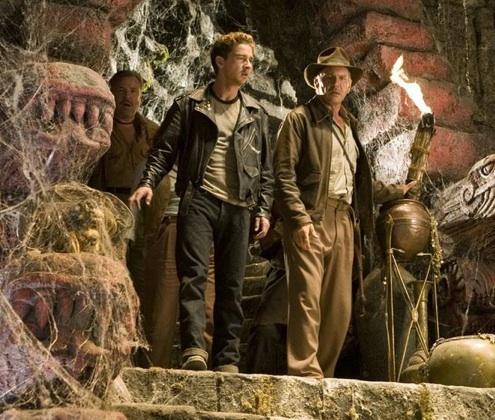 We start with the requisite Indy prologue in 1957 Nevada, where Soviet KGB agents led by Irina Spalko (Cate Blanchett, sporting a tight Soviet uniform, her hair in a black bob cut, an icy expression, and a Russian accent; she never tells Indy ‘ve have vays to make you talk’, but she always seems like she’s about to) have dragged a kidnapped Dr. Jones (Harrison Ford) and his latest sidekick, the unreliable Mac (Ray Winstone), to a secret US army warehouse (the same warehouse where the Ark of the Covenant was stashed away at the end of Raiders). There is something there Spalko wants, and she intends on forcing Indy to find it for her. The item in question turns out to be the legendary Crystal Skull, which she believes has paranormal powers. Apparently Spalko was Stalin’s foremost expert on paranormal studies and believes the skull can be a weapon to tip the scales of the Cold War in the Soviet Union’s favor. Of course this scene ends with a daring Indy escape, and one of the movie’s most clever bits. Indy, on the run from the pursuing Russians, blunders into a town in the middle of the desert, only to find that it’s eerily populated entirely by mannequins, and as the siren begins to wail, realizes to his horror that it is an artificial town built to study the effects of an atomic bomb blast. Making an unlikely but creative escape from seemingly certain doom with the help of what has to be the sturdiest refrigerator on the face of the Earth, Indy eventually manages to make it back to his teaching duties at Marshall College (the first shot of Indy’s university, which looks exactly the same, brings back nostalgic memories). But his troubles are a long way from over. In the climate of 1950s anti-Communist paranoia, Indy’s ‘collaboration’, however unwilling, with Soviet spies, has the FBI taking ‘great interest’ in him, and the sympathetic dean (Jim Broadbent, basically filling in a couple scenes that in the 1980s would have been played by the late Denholm Elliott) has been pressured to show him the door. Indy packs his bags, but no sooner has he boarded the train than he’s approached by a motorcycle-riding young punk called Mutt Williams (Shia LaBeouf), who looks and acts like a Marlon Brando/James Dean wannabe and has come for Indy’s help in finding his mother, who went missing in Peru while herself searching for Professor Oxley (John Hurt), an old colleague of Indy’s, who went mad while obsessively seeking the Crystal Skull. Indy isn’t sure exactly what any of this has to do with him, until he finds out the boy’s missing mother is none other than his old flame Marion Ravenwood (Karen Allen). With Mutt as his self-appointed latest sidekick, Indy sets off on a new adventure that will take him to the depths of the Peruvian jungle, and finds himself in a race against the Soviets led by Spalko to find the legendary Kingdom of the Crystal Skull.
We start with the requisite Indy prologue in 1957 Nevada, where Soviet KGB agents led by Irina Spalko (Cate Blanchett, sporting a tight Soviet uniform, her hair in a black bob cut, an icy expression, and a Russian accent; she never tells Indy ‘ve have vays to make you talk’, but she always seems like she’s about to) have dragged a kidnapped Dr. Jones (Harrison Ford) and his latest sidekick, the unreliable Mac (Ray Winstone), to a secret US army warehouse (the same warehouse where the Ark of the Covenant was stashed away at the end of Raiders). There is something there Spalko wants, and she intends on forcing Indy to find it for her. The item in question turns out to be the legendary Crystal Skull, which she believes has paranormal powers. Apparently Spalko was Stalin’s foremost expert on paranormal studies and believes the skull can be a weapon to tip the scales of the Cold War in the Soviet Union’s favor. Of course this scene ends with a daring Indy escape, and one of the movie’s most clever bits. Indy, on the run from the pursuing Russians, blunders into a town in the middle of the desert, only to find that it’s eerily populated entirely by mannequins, and as the siren begins to wail, realizes to his horror that it is an artificial town built to study the effects of an atomic bomb blast. Making an unlikely but creative escape from seemingly certain doom with the help of what has to be the sturdiest refrigerator on the face of the Earth, Indy eventually manages to make it back to his teaching duties at Marshall College (the first shot of Indy’s university, which looks exactly the same, brings back nostalgic memories). But his troubles are a long way from over. In the climate of 1950s anti-Communist paranoia, Indy’s ‘collaboration’, however unwilling, with Soviet spies, has the FBI taking ‘great interest’ in him, and the sympathetic dean (Jim Broadbent, basically filling in a couple scenes that in the 1980s would have been played by the late Denholm Elliott) has been pressured to show him the door. Indy packs his bags, but no sooner has he boarded the train than he’s approached by a motorcycle-riding young punk called Mutt Williams (Shia LaBeouf), who looks and acts like a Marlon Brando/James Dean wannabe and has come for Indy’s help in finding his mother, who went missing in Peru while herself searching for Professor Oxley (John Hurt), an old colleague of Indy’s, who went mad while obsessively seeking the Crystal Skull. Indy isn’t sure exactly what any of this has to do with him, until he finds out the boy’s missing mother is none other than his old flame Marion Ravenwood (Karen Allen). With Mutt as his self-appointed latest sidekick, Indy sets off on a new adventure that will take him to the depths of the Peruvian jungle, and finds himself in a race against the Soviets led by Spalko to find the legendary Kingdom of the Crystal Skull.
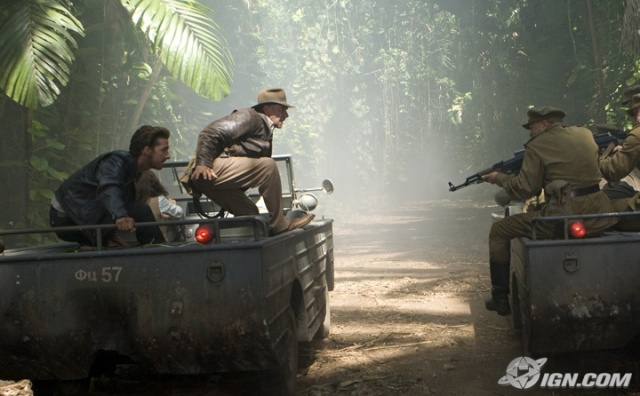 If the above sounds unnecessarily convoluted, that fits the tone of the movie, which has a tendency to get long-winded about things the others wisely kept simple. The Crystal Skull (or skulls, as it turns out) is given the most laborious backstory of any of the series’ MacGuffins, with both Indy and Spalko delivering swaths of exposition about it. The old movies had the right idea; a quick summary and move on. After all, the joy of any Indiana Jones film is not the destination, it’s the journey. The Crystal Skull, like the Ark of the Covenant, the Sankara stones, and the Holy Grail, is a plot device to move us from point A to point B and string the action sequences together. Also, while they’re an obvious choice for the bad guys given the Cold War 1950s setting, the Soviets are somewhat weaker villains than the Nazis. Even Steven Spielberg himself noted once that Nazis are so easy to use as villains because they are a virtually universal symbol of evil; the Soviets just don’t generate the same boo hiss effect. Spalko’s motives are a little murky; a bunch of vague rambling about psychic warfare, using the supposed vast combined mind-controlling power of the reunited skulls to take over the US without firing a shot (‘we will change you”, she says, “and the best part is, you won’t even know it’s happening’). The old movies kept the bad guys’ motives simple: power, world domination, eternal life. Spalko’s seem both underdeveloped and over explained.
If the above sounds unnecessarily convoluted, that fits the tone of the movie, which has a tendency to get long-winded about things the others wisely kept simple. The Crystal Skull (or skulls, as it turns out) is given the most laborious backstory of any of the series’ MacGuffins, with both Indy and Spalko delivering swaths of exposition about it. The old movies had the right idea; a quick summary and move on. After all, the joy of any Indiana Jones film is not the destination, it’s the journey. The Crystal Skull, like the Ark of the Covenant, the Sankara stones, and the Holy Grail, is a plot device to move us from point A to point B and string the action sequences together. Also, while they’re an obvious choice for the bad guys given the Cold War 1950s setting, the Soviets are somewhat weaker villains than the Nazis. Even Steven Spielberg himself noted once that Nazis are so easy to use as villains because they are a virtually universal symbol of evil; the Soviets just don’t generate the same boo hiss effect. Spalko’s motives are a little murky; a bunch of vague rambling about psychic warfare, using the supposed vast combined mind-controlling power of the reunited skulls to take over the US without firing a shot (‘we will change you”, she says, “and the best part is, you won’t even know it’s happening’). The old movies kept the bad guys’ motives simple: power, world domination, eternal life. Spalko’s seem both underdeveloped and over explained.
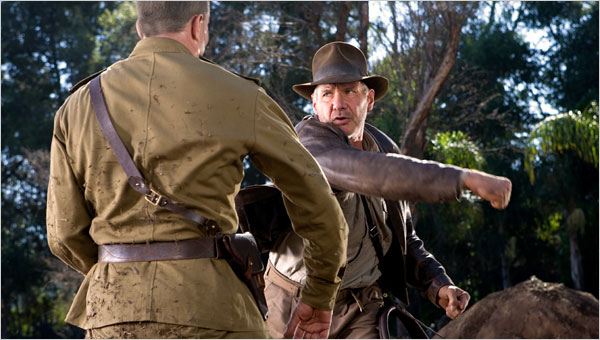 The problem isn’t the cast. Despite the nineteen years that have passed since he last donned the fedora, Harrison Ford slips back into Indiana Jones’ outfit and persona like an old, well-worn, comfortable shoe. Indiana Jones has always been the role Ford seems the most perfectly at home in, and he does an admirable job of slipping back into a character he last played in 1989. It’s telling of Ford’s enjoyment of the role that after a string of bored, autopilot performances in recent roles, he seems easily the most invigorated and enthusiastic here that he’s been at least since 1997’s Air Force One. Of course Ford is much older than in The Last Crusade, and the filmmakers don’t ignore the obvious fact that he is no longer a young man.He’s helped by a screenplay that acknowledges the gap of time and the actor/character’s age. Indy is still in the thick of the action, but the number of extreme stunts (at least those performed by Ford) has been scaled back a few notches, and he’s backed up by the largest group of sidekicks he’s ever had. This time the filmmakers allow Indy to acknowledge that he’s not a young man, and to be a little more of a team player.
The problem isn’t the cast. Despite the nineteen years that have passed since he last donned the fedora, Harrison Ford slips back into Indiana Jones’ outfit and persona like an old, well-worn, comfortable shoe. Indiana Jones has always been the role Ford seems the most perfectly at home in, and he does an admirable job of slipping back into a character he last played in 1989. It’s telling of Ford’s enjoyment of the role that after a string of bored, autopilot performances in recent roles, he seems easily the most invigorated and enthusiastic here that he’s been at least since 1997’s Air Force One. Of course Ford is much older than in The Last Crusade, and the filmmakers don’t ignore the obvious fact that he is no longer a young man.He’s helped by a screenplay that acknowledges the gap of time and the actor/character’s age. Indy is still in the thick of the action, but the number of extreme stunts (at least those performed by Ford) has been scaled back a few notches, and he’s backed up by the largest group of sidekicks he’s ever had. This time the filmmakers allow Indy to acknowledge that he’s not a young man, and to be a little more of a team player.
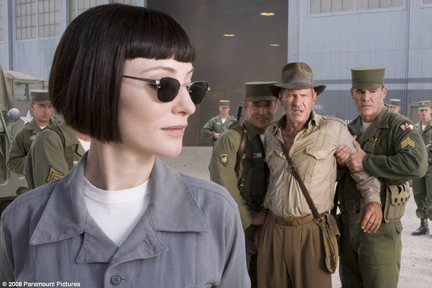 Shia LaBeouf is effective sidekick material. For the very busy young actor, this isn’t the kind of role that’s going to win him acting accolades, but like last year’s Transformers, it’s a further stepping stone toward stardom, and if nothing else LaBeouf, known so far as geeky boy-next-door types, shows that he can venture more into action hero territory without seeming ridiculous. Mutt compliments Indy well, mainly because he’s almost certainly the closest any sidekick has come to being an equal. He’s certainly a lot more appealing and a lot less irritating than Willie Scott or Short Round, and he can take care of himself in a scrape. It’s nice to see a familiar face other than Ford in the form of Karen Allen’s Marion (generally considered his worthiest love interest), but while Allen is throughout the second half of the film, and seems to be having fun returning to the series, she isn’t given much to do besides take the wheel during the lengthiest car chase, and resume her bickering with Indy for a short time before they get mushy like long-lost loves. It’s a bit disappointing that we don’t get any kind of smackdown between Marion and Spalko; in fact, the two women in the cast interact only fleetingly, and Marion doesn’t get to throw a punch. The supporting cast is talent-heavy with highly-regarded character actors- Cate Blanchett, Ray Winstone, John Hurt, Jim Broadbent- none of whom are given anything challenging. Cate Blanchett is underused, not given much to do besides stalking around looking stern, providing exposition about the Crystal Skull, threatening various characters with her rapier, and chasing Indy and company around the jungle, and is nowhere near Ronald Lacey’s Toht’s or Amrish Puri’s Mola Ram’s levels of nastiness. In fact, she’s disappointingly bland. Ray Winstone’s Mac is a plot device who switches allegiances whenever the script needs another twist. John Hurt is even more wasted, given nothing to do but wander around looking vacant and muttering unintelligibly. Even when he finally becomes lucid again, it’s too late for him to make an impression, and even then his utterances are less than profound; when Indy asks if the skulls’ owners have returned to outer space, Oxley replies ‘not space, but the space between spaces’. Huh? Part of what sometimes drags Crystal Skull down is the excess of supporting characters; what makes it worse is that they’re as flat as the pages they’re written on. Granted, we don’t come to Indiana Jones movies for deep character development, but previous supporting players, like Karen Allen’s Marion, Paul Freeman’s Belloq, Ronald Lacey’s Toht, and John Rhys-Davies’ Sallah all had a spark of something distinct about them that Spalko, Mac, and Oxley are missing.
Shia LaBeouf is effective sidekick material. For the very busy young actor, this isn’t the kind of role that’s going to win him acting accolades, but like last year’s Transformers, it’s a further stepping stone toward stardom, and if nothing else LaBeouf, known so far as geeky boy-next-door types, shows that he can venture more into action hero territory without seeming ridiculous. Mutt compliments Indy well, mainly because he’s almost certainly the closest any sidekick has come to being an equal. He’s certainly a lot more appealing and a lot less irritating than Willie Scott or Short Round, and he can take care of himself in a scrape. It’s nice to see a familiar face other than Ford in the form of Karen Allen’s Marion (generally considered his worthiest love interest), but while Allen is throughout the second half of the film, and seems to be having fun returning to the series, she isn’t given much to do besides take the wheel during the lengthiest car chase, and resume her bickering with Indy for a short time before they get mushy like long-lost loves. It’s a bit disappointing that we don’t get any kind of smackdown between Marion and Spalko; in fact, the two women in the cast interact only fleetingly, and Marion doesn’t get to throw a punch. The supporting cast is talent-heavy with highly-regarded character actors- Cate Blanchett, Ray Winstone, John Hurt, Jim Broadbent- none of whom are given anything challenging. Cate Blanchett is underused, not given much to do besides stalking around looking stern, providing exposition about the Crystal Skull, threatening various characters with her rapier, and chasing Indy and company around the jungle, and is nowhere near Ronald Lacey’s Toht’s or Amrish Puri’s Mola Ram’s levels of nastiness. In fact, she’s disappointingly bland. Ray Winstone’s Mac is a plot device who switches allegiances whenever the script needs another twist. John Hurt is even more wasted, given nothing to do but wander around looking vacant and muttering unintelligibly. Even when he finally becomes lucid again, it’s too late for him to make an impression, and even then his utterances are less than profound; when Indy asks if the skulls’ owners have returned to outer space, Oxley replies ‘not space, but the space between spaces’. Huh? Part of what sometimes drags Crystal Skull down is the excess of supporting characters; what makes it worse is that they’re as flat as the pages they’re written on. Granted, we don’t come to Indiana Jones movies for deep character development, but previous supporting players, like Karen Allen’s Marion, Paul Freeman’s Belloq, Ronald Lacey’s Toht, and John Rhys-Davies’ Sallah all had a spark of something distinct about them that Spalko, Mac, and Oxley are missing.
The only thing belying that Ford’s not as light on his feet as he used to be is the noticeably reduced number of major stunts he performs. That’s not to say he doesn’t do any, they’re just not the steady series he performed in previous outings. Ford’s best stunt work (if it’s all actually Ford, and it appears to be), is in the first third, especially during his warehouse escape, where he whips guns out of the bad guys’ hands, scrambles around over mountains of crates, swings from the rafters onto moving cars, and basically establishes that Indy is still Indy. It’s good that he gets this showcase, because after that Indy spends most of his time on the ground. There’s two car chases, and a fistfight, but not much swinging around (at least not by Indy). The next big action scene is a chase with Indy and Mutt on Mutt’s motorcycle tearing around and through Marshall College with Russkies in hot pursuit that ends up in the library. Maybe the movie’s most memorable action bit comes during this sequence, in which Indy is pulled off Mutt’s motorcycle and into the Russians’ car, and manages to fight his way out the other window and back onto the motorcycle. It combines nifty stunt work and clever action-comedy in the best tradition of Indiana Jones. Unfortunately, the movie is low on action for a while after that, and we spend time on Indy and Mutt trekking around Peru and too much talking about the Crystal Skull. The movie’s key action setpiece, a lengthy and somewhat disorganized car chase through the jungle , is hampered by too much CGI and too much silliness, including Mutt swinging through the trees like Tarzan. The earlier motorcycle chase has a nicely old-fashioned, no frills feel, and would have fit perfectly at home in any of the previous films, but the jungle chase does not. Despite some nifty stuntwork with Mutt and Spalko fencing on the tops of racing cars, this sequence still feels a pale shadow of the truck chase in Raiders, the tunnel race in Temple, or the tank duel in Last Crusade, and is indicative of the way the overall energy level is lower here.
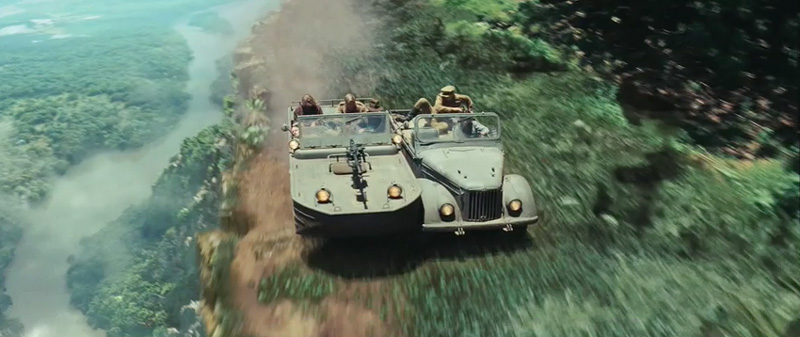 Spielberg and Lucas pull out all the stops to make this ‘feel’ like an Indiana Jones movie, relying in large part on the nostalgia many viewers will have for the original trilogy. There’s the old-fashioned Paramount mountain opening logo (one wonders if it’s a Lucas in-joke about lowering expectations when it turns into a prairie dog hill). We see pictures of Marcus Brody and Henry Jones Sr. Marshall College looks exactly the same. We revisit the same warehouse we saw at the end of Raiders, and the Ark of the Covenant makes a brief ‘cameo’. There’s the opening prologue action sequence featuring a tight spot and a daring Indy escape (although unlike the others, this one actually ties directly in with the main plot). There’s Indy’s fistfight with a hulking henchman, with Igor Jijikine filling in for the late Pat Roach. There’s also the obligatory creepy crawlies gross out moment, this time involving voracious red ants and borrowing a page from the man-eating beetles in The Mummy. The plot, while unnecessarily convoluted, very much follows the same blueprint as the others, particularly Raiders and Last Crusade: evil enemy military power seeks legendary object to tip scales in its favor, Indy and assorted sidekicks travel to remote regions racing against the baddies using clues in old legends and artifacts. There’s a ‘surprise revelation’ about a character that is unlikely to come as much of a shock for anyone who hasn’t been living under a rock for the past few months. The filmmakers also take advantage of the 1950s setting, starting right out with the opening, as Elvis Presley’s ‘You Ain’t Nothing But a Hound Dog’ blasts from radios, Howdy Doody is glimpsed on black-and-white television sets, Indy wanders onto atomic bomb test sites, his comeback when Spalko asks if he has any defiant last words is ‘I like Ike’ (this might go over some younger viewers’ heads, but some of the older audience members I attended with got a laugh out of it), and Mutt is introduced riding his Harley onto the screen dressed exactly like Marlon Brando in 1953’s The Wild One, down to the crooked cap. It has a lot of the familiar Indy ingredients, but there’s just not as much spark, and the energy and excitement level ebbs, with even the most exciting sequences not as exciting as what the series served up in the ’80s.
Spielberg and Lucas pull out all the stops to make this ‘feel’ like an Indiana Jones movie, relying in large part on the nostalgia many viewers will have for the original trilogy. There’s the old-fashioned Paramount mountain opening logo (one wonders if it’s a Lucas in-joke about lowering expectations when it turns into a prairie dog hill). We see pictures of Marcus Brody and Henry Jones Sr. Marshall College looks exactly the same. We revisit the same warehouse we saw at the end of Raiders, and the Ark of the Covenant makes a brief ‘cameo’. There’s the opening prologue action sequence featuring a tight spot and a daring Indy escape (although unlike the others, this one actually ties directly in with the main plot). There’s Indy’s fistfight with a hulking henchman, with Igor Jijikine filling in for the late Pat Roach. There’s also the obligatory creepy crawlies gross out moment, this time involving voracious red ants and borrowing a page from the man-eating beetles in The Mummy. The plot, while unnecessarily convoluted, very much follows the same blueprint as the others, particularly Raiders and Last Crusade: evil enemy military power seeks legendary object to tip scales in its favor, Indy and assorted sidekicks travel to remote regions racing against the baddies using clues in old legends and artifacts. There’s a ‘surprise revelation’ about a character that is unlikely to come as much of a shock for anyone who hasn’t been living under a rock for the past few months. The filmmakers also take advantage of the 1950s setting, starting right out with the opening, as Elvis Presley’s ‘You Ain’t Nothing But a Hound Dog’ blasts from radios, Howdy Doody is glimpsed on black-and-white television sets, Indy wanders onto atomic bomb test sites, his comeback when Spalko asks if he has any defiant last words is ‘I like Ike’ (this might go over some younger viewers’ heads, but some of the older audience members I attended with got a laugh out of it), and Mutt is introduced riding his Harley onto the screen dressed exactly like Marlon Brando in 1953’s The Wild One, down to the crooked cap. It has a lot of the familiar Indy ingredients, but there’s just not as much spark, and the energy and excitement level ebbs, with even the most exciting sequences not as exciting as what the series served up in the ’80s.
Another disappointing aspect is that the frantic second half never slows down enough for more than the most perfunctory ‘bonding’ between Indy and Mutt. There’s a missed opportunity to develop Indy and Mutt’s relationship into something like Indy’s relationship with his dad in The Last Crusade, another drawback of the excess of characters diluting the focus on the key relationship between Indy, Mutt, and Marion. Likewise, there’s still chemistry between Ford and Karen Allen, but their renewed relationship is given only the most perfunctory attention. One minute they’re bickering as though Raiders never ended, the next they’re getting mushy and giving each other adoring looks in between action sequences, which barely slow down long enough for them to catch a breath. This makes the epilogue in particular feel out of left field. It will undoubtedly provide satisfying closure for some Indy-Marion fans, but it doesn’t have enough leading up to it, and ends the movie on a somewhat ho-hum note. Spielberg and Lucas use CGI too liberally, throwing in some silly bits like reaction shots from animated prairie dogs (what, they couldn’t find any real prairie dogs?), and Mutt aping Tarzan (accompanied, as if the scene isn’t already goofy enough, by a small army of CGI monkies) at the lowest point of the jungle chase sequence. Indiana Jones movies have always been relatively tongue-in-cheek and not taken themselves terribly seriously, but these moments cross the line into too over-the-top attempts at comic relief.
Kingdom of the Crystal Skull isn’t unwatchable, but the freshness and energy of the original trilogy is sputtering at best. Harrison Ford still wears the fedora well, an underused Marion is better than no Marion, Shia LaBeouf is a welcome addition, and while the jungle chase gets a little carried away with CGI, . Nonetheless, the series is noticeably creaking with age here, and I think it’s time to Indy to hang up the whip.
**1/2
K-19: The Widowmaker (2002)
CAST: Harrison Ford, Liam Neeson, Peter Sarsgaard, Donald Sumpter, Ravil Isyanov, Christian Camargo, John Shrapnel, Joss Ackland
REVIEW:
WARNING: THIS REVIEW WILL REVEAL ASPECTS OF THE FILM’S PLOT
Following in the vein of such films as Das Boot and Crimson Tide, K-19: The Widowmaker is a thriller with an epic backdrop of historical conflict unfolding within the claustrophobic confines of a submarine. Kathryn Bigelow’s entry in the submarine genre doesn’t rewrite the book on anything—in fact, at times it’s cobbled together out of cliches, despite being based on an actual incident—but it’s well-made and engaging, and hits the expected points effectively. Continue reading
Air Force One (1997)
CAST: Harrison Ford, Gary Oldman, Glenn Close, Wendy Crewson, Liesel Matthews, Dean Stockwell, William H. Macy, Paul Guilfoyle, Xander Berkeley, Philip Baker Hall, Jurgen Prochnow
REVIEW:
Air Force One, the third major American action thriller from German director Wolfgang Petersen (following In the Line of Fire and Outbreak), proves that an accomplished action director can turn a flimsy premise into an entertaining ride, smoothly distracting from some plot holes and implausibiliites to turn Air Force One into one of the better of the myriad Die Hard-esque action flicks that have come out in the years since 1988’s Die Hard popularized the basic premise. It’s not as good as the original Die Hard, but it’s an entertaining ride if you don’t scrutinize everything too closely. Continue reading
Regarding Henry (1991)
CAST: Harrison Ford, Annette Bening, Mikki Allen, Bill Nunn, Bruce Altman, Rebecca Miller, Donald Moffat
REVIEW:
There’s the potential of a deeper, more complex movie somewhere inside Regarding Henry, but Mike Nichols’ direction and J.J. Abrams’ script never aims any higher than earnestly treacly “feel good” fluff that paints both the title character’s rehabilitation and character arc (if it can be called that) in simplistic shallow black-and-white. The result is too technically competent and earnestly intentioned to hate, but its oversimplifications are irritatingly in the way of a better rendition of the basic premise. Continue reading
Indiana Jones and the Last Crusade (1989)
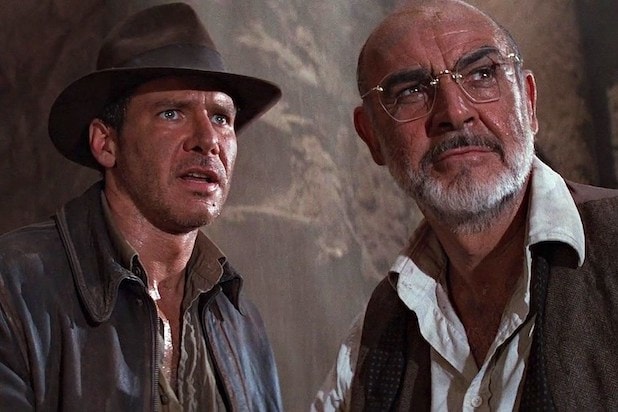
DIRECTOR: Steven Spielberg
CAST:
Harrison Ford, Sean Connery, Allison Doody, Denholm Elliott, John Rhys-Davies, Julian Glover, Michael Byrne, River Phoenix
REVIEW:
After the general disappointment over Temple of Doom —and the film’s occasional weirdness — Last Crusade, as if deciding to play it safe, takes us back into familiar territory: Indy revisits the deserts of the Middle East in search of an ancient legendary religious artifact, the Nazis are once again the bad guys, Denholm Elliott’s Marcus Brody and John Rhys-Davies’ Sallah return, and the most exciting and extended action sequence is a duel between Indy and the Nazis in the desert. To help avoid making Last Crusade seem like too much of a retread of Raiders of the Lost Ark , we have Sean Connery thrown into the mix as Indy’s never-before-seen father. To this end, while it’s neither as original nor as fresh as Raiders of the Lost Ark, The Last Crusade is a marked improvement over Temple of Doom with a higher energy level, and the father-son relationship opens the door to some fresh material that adds a welcome spark.
Witness (1985)
DIRECTOR: Peter Weir
CAST:
Harrison Ford, Kelly McGillis, Lukas Haas, Jan Rubes, Alexander Godunov, Josef Sommer, Danny Glover, Patti LuPone, Brent Jennings, Angus MacInnes
REVIEW:
Witness is billed as a thriller or a crime drama, but that’s just the plot skeleton. What it’s really about at its core is love and longing, and about how the randomness of life can throw two people into contact long enough to fall in love, even if they can never truly be together. Continue reading
Indiana Jones and the Temple of Doom (1984)
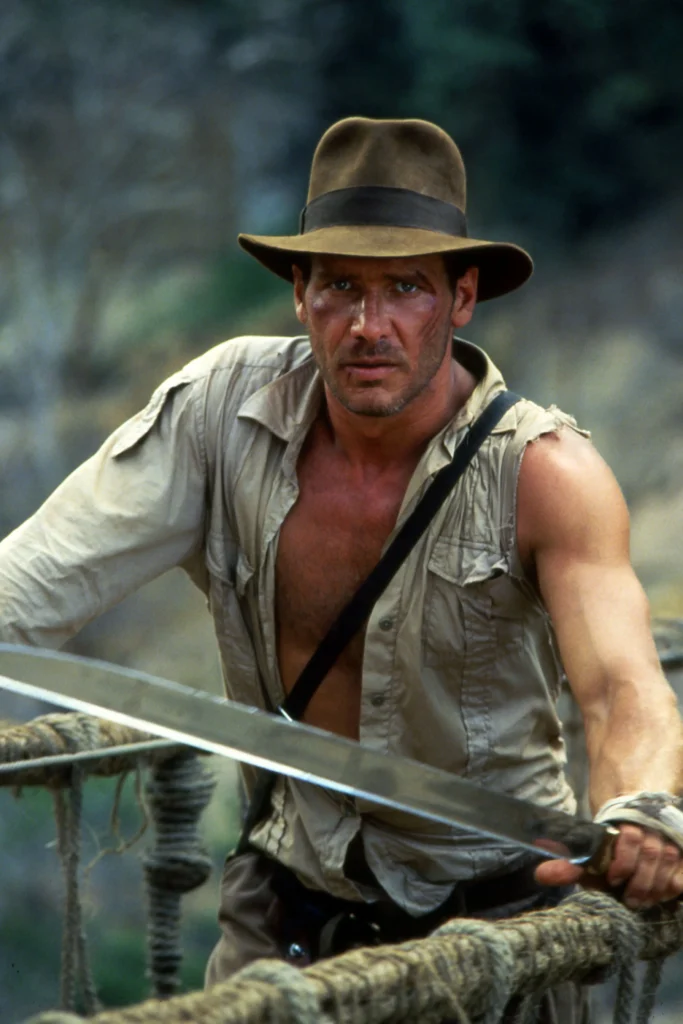
DIRECTOR: Steven Spielberg
CAST: Harrison Ford, Kate Capshaw, Ke Huy Quan, Amrish Puri, Roshan Seth, Philip Stone
REVIEW:
Just as the near-perfect action-adventure of 1981’s Raiders of the Lost Ark virtually guaranteed that more installments in what became the Indiana Jones series would follow, it was also perhaps inevitable that they would fall short of its high water mark. Temple of Doom is by no means a bad movie, and parts of it are as wildly entertaining as the best Raiders had to offer, but it lacks the perfect pacing and tonal balance of the first installment, and suffers by comparison. Continue reading
Star Wars Episode VI: The Return of the Jedi (1983)

DIRECTOR: Richard Marquand
CAST: Mark Hamill, Harrison Ford, Carrie Fisher, Billy Dee Williams, Ian McDiarmid, Anthony Daniels, Kenny Baker, Peter Mayhew, Frank Oz (voice), Alec Guinness, David Prowse, James Earl Jones (voice)
REVIEW:
After 1980’s The Empire Strikes Back, The Return of the Jedi feels like a disappointing downgrade. The film does the job of bringing the original trilogy, the galactic civil war, and the stories of its heroes to a conclusion and give the Rebel Alliance a grand victory, but it accomplishes this in an underwhelming manner. Little of the comparative levels of darkness and thematic depth established by Empire Strikes Back is carried over here. To be sure, there are good things to be found, but it involves sifting through a mixed bag of overly kiddie-friendly goofiness that unfortunately would in hindsight be a harbinger of what was in store for the long-gestating prequels.
Continue reading